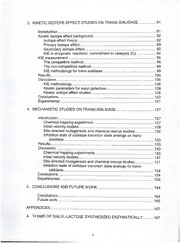
Transition state and mechanistic study of Trypanosoma cruzi trans-sialidase PDF
Preview Transition state and mechanistic study of Trypanosoma cruzi trans-sialidase
TRANSITIONSTATEANDMECHANISTICSTUDYOFTRYPANOSOMACRUZI TRANS-SIALIDASE By JINGSONGYANG ADISSERTATIONPRESENTEDTOTHEGRADUATESCHOOL OFTHEUNIVERSITYOFFLORIDAINPARTIALFULFILLMENT OFTHEREQUIREMENTSFORTHEDEGREEOF DOCTOROFPHILOSOPHY UNIVERSITYOFFLORIDA 2001 ACKNOWLEDGMENTS Iamdeeplyindebtedtomyresearchadvisor,Dr.BenjaminA.Horenstein. Iwouldliketoexpressmysincerestgratitudeforhisguidanceandsupportduring thecourseofthisprojectandforbeingsuchapatientandhelpingperson. My appreciation also goes to Dr. Nigel Richards, Dr. Jon Stewart, Dr. David Silvermanand Dr.WeihongTanforservingontheadvisorycommitteeandfor giving their time and experience to improve my professional development in chemistryandbiology. SpecialthanksgotoDr.SergioSchenkmanforhisgenerosityinproviding us the plasmids for trans-sialidase overexpression, which started the entire project. I wish to express mythanks to the past and present Horenstein group members-Mike, Eve, Kim, John, Hongbin, Mirela, Katie, Hongyi, and Erin-for theircompanyandsupport. SpecialthanksgotoMikeandEvefortheirhelpin the laboratory. I would also liketothank Romaineforprintingthedissertation andSimonforcomputerhelp. Anappreciationextendstoallmycolleaguesin theBiochemistryDivision,too. IamthankfulformyfriendsBaocaiandWentaofortheirhospitalityandfor allthefuntimewehavebeenenjoyingtogether. Aspecialappreciationisalso extendedtoallofmyfriendsinUFwhomademystayinGainesvilleapleasant experience. I am deeply indebtedto mywife, Nianying, for herpatience, friendship, supportandloveatalltimes. Withouthersupportnoneofmyaccomplishments would have been possible. I would also like to thank my daughter, Xinyue (Sherry),forallthefunandjoywehavebeensharingtogether. Mygratitudealso goestoallofmyfamilymembersfortheirconstantunderstandingandsupport. Finally, IwouldliketothanktheNationalScienceFoundationforfunding and the University of Florida for providing the facilities and an excellent environmenttocompletethiswork. in TABLEOFCONTENTS page ACKNOWLEDGMENTS ii ABSTRACT vii CHAPTERS 1. INTRODUCTION 1 Sialicacids 2 Chagas'disease, TrypanosomacruziandTrans-sialidase 8 Glycosylhydrolasesandglycosyltransferases 14 Enzymesthathydrolyseortransfernon-sialosugars:lysozyme and(3-galactosidases 15 Enzymesthathydrolyseortransfersialosugars:sialidasesand sialyltransferases 22 MechanisticbackgroundofTrypanosomacruzitrans-sialidase 34 2. RECOMBINANTTRANS-SIALIDASEOVEREXPRESSIONAND SUBSTRATESYNTHESIS 37 Introduction 37 Results 38 Discussion 43 Overexpressionandpurificationofrecombinanttrans-sialidase 43 Synthesisof([6-3H]Glc)Lactose 46 Synthesisofsialyl-lactoseisotopomers 47 Synthesisofsialyl-galactoseisotopomers 53 Characterizationofsialyl-lactoseandsialyl-galactose isotopomers 54 Purificationofa-2,3-sialyl-lactosefrombovinecolostrum 55 Synthesisof[3,3'-dideuterio,3H-N-acetyl]sialyl-cc-D-octyl- galactose 58 Syntheticrouteforthepreparationof([3-3H,3-180)]Gal)sialyl- galactose 61 Experimental 81 IV 3. KINETICISOTOPEEFFECTSTUDIESONTRANS-SIALIDASE 81 Introduction 81 Kineticisotopeeffectbackground 82 Isotopeeffecttheory 82 Primaryisotopeeffect 89 Secondaryisotopeeffect 90 KIEinenzymaticreactions:commitmenttocatalysis(Cf) 94 KIEmeasurement 95 Thecompetitivemethod 96 Thenon-competitivemethod 99 KIEmethodologyfortrans-sialidase 99 Results 100 Discussion 106 KIEmethodology 106 Kineticparametersforsialyl-galactose 108 Kineticisotopeeffectstudies 108 Conclusions 120 Experimental 121 4. MECHANISTICSTUDIESONTRANS-SIALIDASE 127 Introduction 127 Chemicaltrappingexperiment 127 Initialvelocitystudies 128 Site-directedmutagenesisandchemicalrescuestudies 132 Inhibitiontestsofsialidasetransitionstateanalogsontrans- sialidase 133 Results 135 Discussion 143 Chemicaltrappingexperiments 143 Initialvelocitystudies 147 Site-directedmutagenesisandchemicalrescuestudies 151 Inhibitiontestsofsialidasetransitionstateanalogsontrans- sialidase 154 Conclusions 154 Experimental 155 5. CONCLUSIONSANDFUTUREWORK 164 Conclusions ..164 Futurework 155 APPENDICES 167 A 1HNMROFSIALYL-LACTOSESYNTHESIZEDENZYMATICALLY 167 B 1HNMROFSIALYL-GALACTOSESYNTHESIZEDENZYMATICALLY....168 C 1HNMROF4,6-BENZYLIDENE-A-D-METHYLGALACTOSIDE 169 D 1HNMROF2-BENZOYL-4.6-BENZYLIDENE-A-D-METHYL GALACTOSIDE 170 E 1HNMROF2-BENZOYL-3-KETP-4,6-BENZYLIDENE-A-D-METHYL GALACTOSIDE 171 REFERENCES 172 BIOGRAPHICALSKETCH 183 VI AbstractofDissertationPresentedtotheGraduateSchool oftheUniversityofFloridainPartialFulfillmentofthe RequirementsfortheDegreeofDoctorofPhilosophy TRANSITIONSTATEANDMECHANISTICSTUDYOF TRYPANOSOMACfll/Z/TRANS-SIALIDASE By JingsongYang May,2001 Chair: Dr.BenjaminA.Horenstein MajorDepartment: Chemistry Trypanosomacruzitrans-sialidasetransfersthesialicacidgroupfromhost cellsurfaceglycoconjugatesto parasitesurfaceglycoconjugates ortowater, a function believed to be involved in the pathogenic process of T. cruzi, the causative agent of Chagas' disease. Trans-sialidase belongs to a family of glycosyltransferases whose mechanisms of action have not been well characterized. This dissertation describes the transition state analysis and mechanistic study on trans-sialidase with the long term goal of providing mechanistic informationforthedesign ofspecifictrans-sialidase inhibitors that mayhaveclinicalapplication. Thefirstpartofthisworkdescribestheoverexpressionandpurificationof recombinant trans-sialidase, and the synthesis of a series of substrates necessaryforthekineticexperiments. Twosubstrates,sialyl-lactoseandsialyl- vii galactose,with awidevarietyofisotopiclabels inspecificpositionshavebeen synthesized. Thesyntheticapproach,purity,yieldandcharacterizationofthese moleculesispresented. Thekineticisotopeeffectstudieswiththeabovementionedsubstratesare discussednext. Theseincludethemeasurementsof13Cprimaryisotopeeffects and(3-dideuteriosecondaryisotopeeffects. Bothnon-enzymaticsolvolysisand enzymatictransferreactions have been investigated. The solvolysis reactions serve as a point of comparison forthe enzyme catalyzed reactions. Kinetic isotope effects have been measured with both the natural substrate, sialyl- lactose, and the slow substrate, sialyl-galactose. The results from these experimentsarecomparedandthetransitionstatestructurefortrans-sialidaseis proposed. The dissertation concludes with the discussion of a series of kinetic experimentsontrans-sialidase. Theseincludeinitialvelocitykinetics,achemical trapping experiment, site-directed mutagenesis experiments and inhibition studies. The results of these experiments are discussed and a reaction mechanismfortrans-sialidaseisproposed. VIII CHAPTER 1 INTRODUCTION TrypanosomacruziisthecausativeagentofhumanChagas'disease,an epidemicillnessprevalentinCentralandSouthAmerica. T.cruziexpresseson itssurfacethetrans-sialidaseactivitythattransfersthesialicacidgroupfromhost cell surface glycoconjugates to its own surface glycoconjugates (transferase activity)or,lessefficiently,towater(hydrolaseactivity). Itistheonlyenzymethat creatsglycosidicbondstosialicacidwithoutusingcytidine-5'-monophosphate-N- acetyl-neuraminic acid (CMP-NeuAc) as the donor substrate. A better understandingofthemechanismandfunctionoftrans-sialidase maycontribute tothecontrolofChagas'diseaseandalsomayallowustohaveinsightintowhy thishomologofthesialidasespreferstransferaseactivityratherthan hydrolase activity. The work presented in this dissertation represents a study of the transition state structure and mechanism oftrans-sialidase, with the longterm goalofprovidingmechanisticinformationforthedesignofspecifictrans-sialidase inhibitorswithpossibleextensiontotheneuraminidasesandsialidaseswhichare structurallyhomologous. 2 SialicAcids Trans-sialidase is involved in the transfer of sialic acid between glycoconjugates. Itfunctionsbyalteringthedistributionsofsialicacidsonboth thehostcellandtheparasite'sowncellsurface. Therefore,thebiologicalroles of trans-sialidase are closely related to the functions of sialic acids. A brief reviewofthebiologicalfunctionsofsialicacidsisgivenbelowforthepurposeof helpingreadersbetterunderstandhowtrans-sialidaseactivitymightbeinvolved inthepathogenicprocessofTrypanosomacruzi. Sialic acids (figure 1-1) are composed of a family of derivatives of neuraminic acid (5-amino-3,5-dideoxy-D-g/ycero-D-ga/acto-nonulosonic acid). Up to now, 36 different sialic acid molecules have been found in various organisms. Theyare usuallylinkedtothecarbohydratechain ofglycoproteins and glycolipids via oc-glycosidic bonds (1,2). Sialic acids and sialic acid conjugatesexhibitavarietyofstructuralfeatures. Sialicacidscanbe linkedto thepolysaccharidechainviaeithera-2,3,a-2,6,ora-2,8glycosidicbonds(1,2). Terminalsialicacidsusuallyforma-glycosidicbondsbetweenC-2hydroxylofthe sialicacidmoleculeandC-3,-4and-6ofthepenultimatenon-sialicacidmoiety, such as galactose (Gal), N-acetylglucosamine (GlcNAc) and N- acetylgalactosamine (GalNAc), with the most common linkages being a-2,3to Galanda-2,6toGalandGalNAc. ThesecanbefoundinbothN-andO-linked glycoproteins. Sialic acids also attachtoothersialicacid molecules via a-2,8 linkage in oligosialylglycoconjugate and sialylpolysaccharide structures. These structures are found in bacterial saccharides and glycoproteins as well as in
